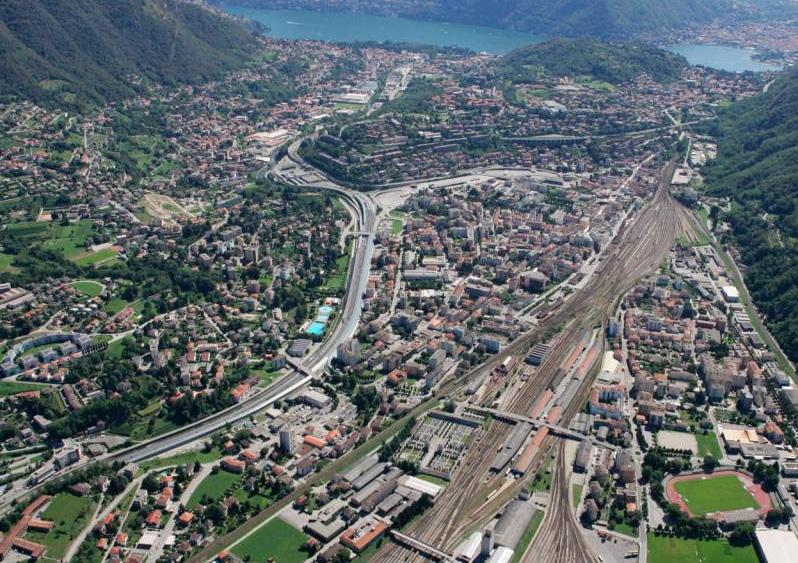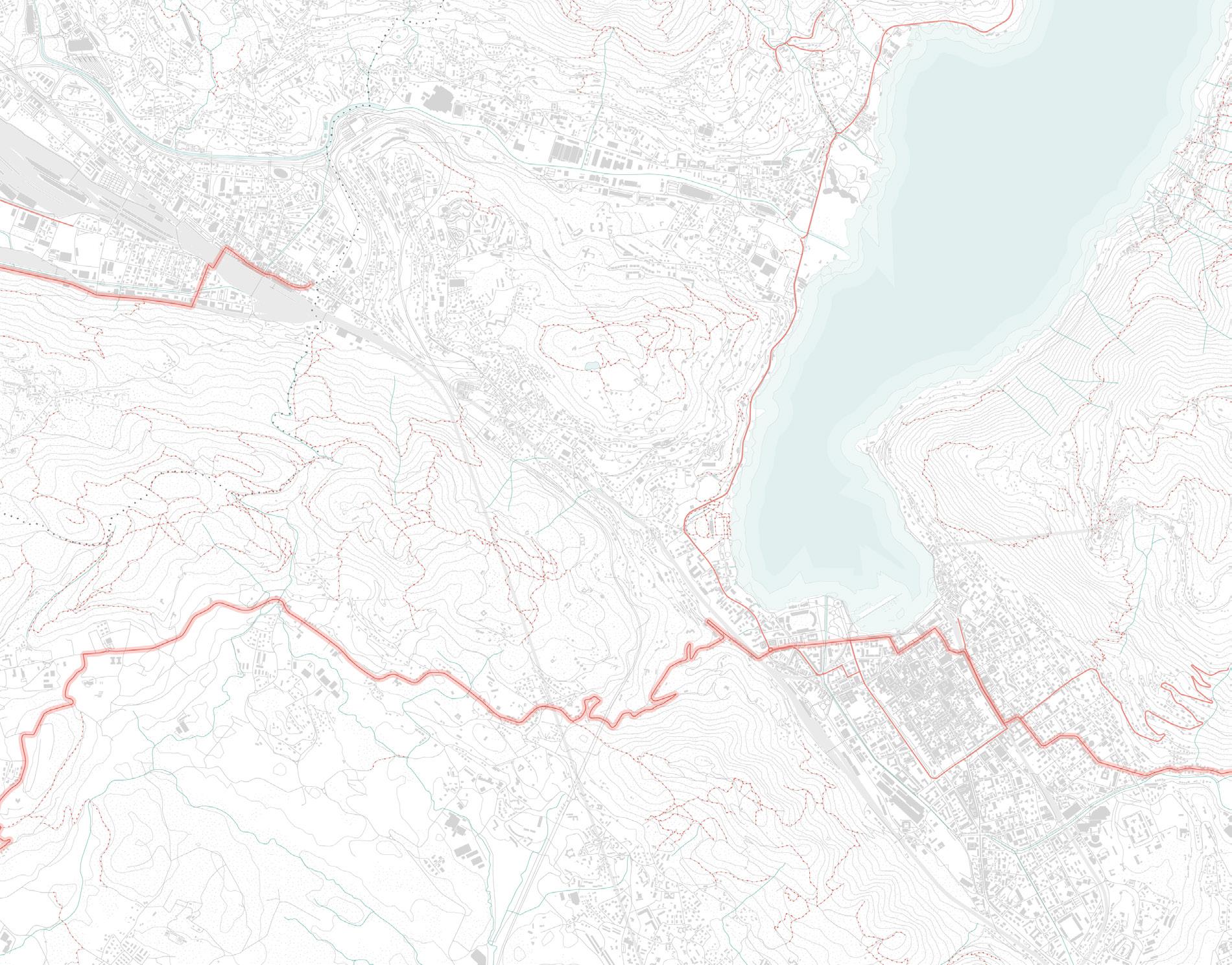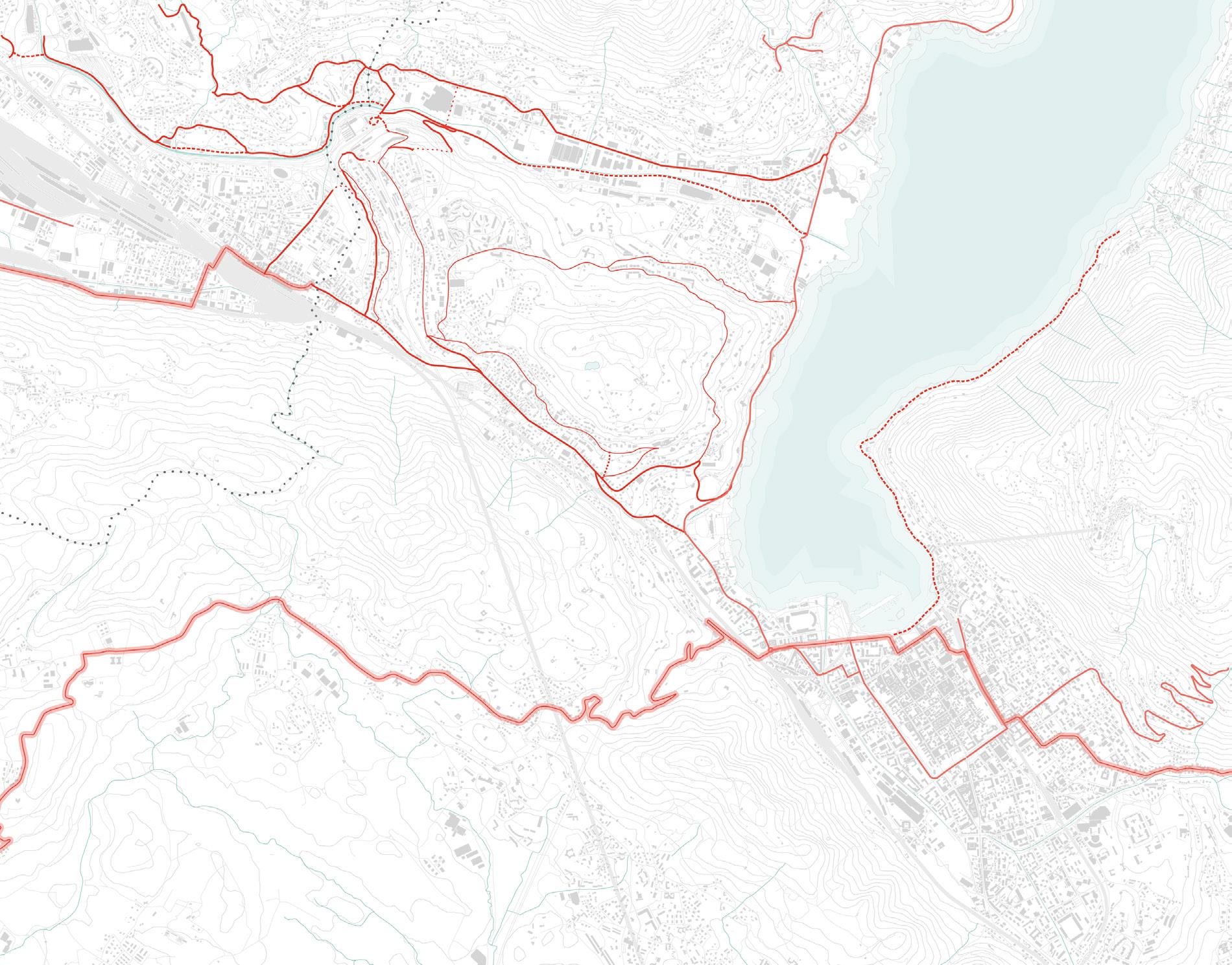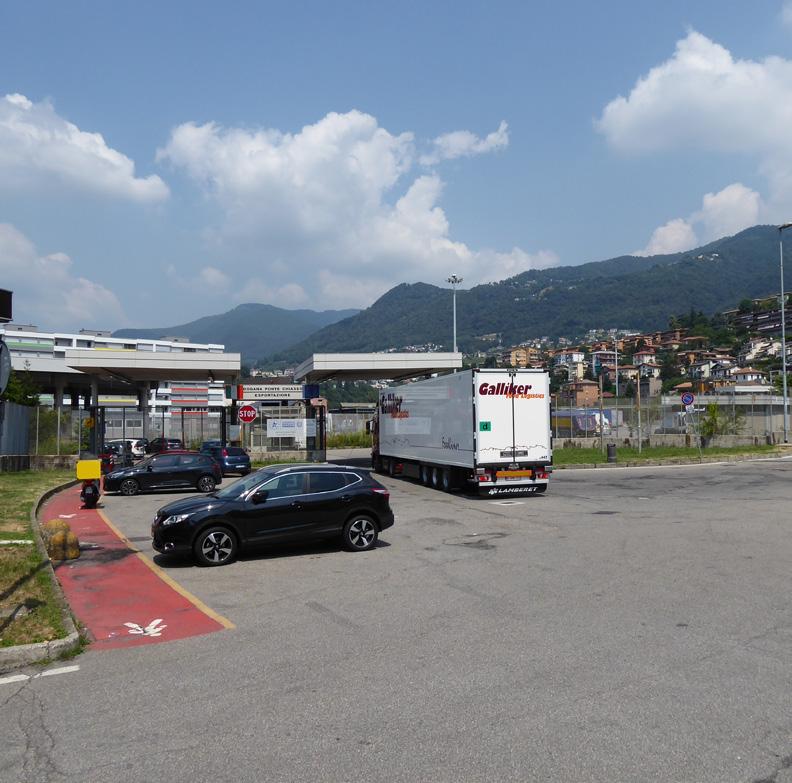
6 minute read
BORDERS ARE DEFINED BY MOVEMENTS OF PEOPLE, PRODUCTS AND INFORMATION
1
Borders are defined by movements of people, products and information.
Advertisement
3.1 | Exclusive cross-border mobility 3.2 | Inclusive mobility 3.3 | Lack of slow traffic networks 3.4 | Towards a new border typology The first in a sequence of three observations suggests that ComoChiasso’s border area is strongly shaped by mobility.
The chapter shows how the Como-Chiasso border area is defined by large-scale infrastructures and identifies a twofaced border condition, which is on the one hand smoothened to the utmost to increase efficiency of crossing, and on the other completely hardened to prohibit crossing.
The chapter suggest that, in order to reach a border condition that offers equitable opportunities for all actors in border space, inclusive mobility should be persued. Inclusive mobility as an objective encompasses the ambition of equitable access to opportunities, by securing the possibility to be mobile for all people.
3.1 | Exclusive cross-border mobility
Cross-border mobility is a specific form of mobility that is driven by different circumstances that are created because of the presence of a nation-state border. The border, in other words, creates conditions that make people want to cross - whether this is because of lower petrol prices, higher salaries or a social system that can offer safety and comfort to those from a country without.
For those who are entitled to participate in the movement of capital, product and people across a relatively borderless world, borders are smoothened and ease of crossing is facilitated in order to reach optimal economic efficiency10. For those who are not expected to contribute to the growth of the nation, instead, the border functions as a waiting space in which life is put on hold as one waits for the unlikely approval to cross11. This distinguishes two types of borders: smooth and hard borders.
While the establishment of the European Union suggests the development of smooth borders throughout Europe to improve the freedom of movement within the EU, ever since the so-called European ‘refugee crisis’, Europe’s nation-state borders have become hard borders for a small part of society. This means borders are often both smooth and hard borders at the same time - depending on who is asking. This is also the case in Como-Chiasso.
The Como-Chiasso border area is a mobility hot-spot. Each day, seventy-thousand Italians cross the border at the Como-Chiasso border control points to go to work in
10 Ulrich Beck, ‘Mobility and the Cosmopolitan Society’. Mobility and the Cosmopolitan Perspective (2004).
11 Michel Agier, Borderlands: Towards an Anthropology of the Cosmopolitan Condition (Cambridge: Polity Press, 2016).
Figure 12 Above Aerial photo of Chiasso, looking towards the Como lake. By Foto CdT/BP e Zocchetti. Retrieved from: < https://www.cdt.ch/ticino/ chiasso-si-riprende-il-suocuore-EJ1469336 >


Switzerland12. For them, the border is a smooth border. The extreme focus on the development of heavy infrastructures has lead to unattractive spatial conditons for the Como-Chiasso area. Hiding away between highways and railways, the housing
possibilities and public facilities in the Como-Chiasso border area are scarce and
the area is better hurried through than dwelled in. This is fine for those who can race past borders, but for those for whom the border is hard, this has become a problem.
3.2 | Inclusive mobility
Generally, when thinking of mobility, the geographic displacement of people and products comes to mind. This type of mobility can be referred to as ‘spatial mobility’. Mobility, however, also incorporates social aspects. This means apart from understanding mobility solely as ‘spatial mobility’, ‘social mobility’ should be considered13 .
Changing spatial mobility can influence social mobility. The integration of spatial and social mobility follows the idea that the way in which resources are distributed and accessed, influences a person’s potential to benefit from opportunities14 . Having less access to resources, such as is the case in hard borders, makes one less apt to climb the social ladder. As resources are made accessible partially through spatial mobility, improving the inclusive accessibility of spatial mobility can lead to an improved, equally distributed social mobility. In this, it is not only the actual physical displacement that is relevant to social mobility, but rather the potential to move. Knowing how to (and deciding to) ‘be mobile’ gives a person access to other opportunities to develop.
3.3 | Lack of slow traffic networks
Currently, car-traffic is dominant in the Como-Chiasso border area. But not all inhabitants in border space can afford to own a car. In order to reach optimal inclusive accessibility to opportunities, various means of mobility should be developed along the Como-Chiasso border.
As stated before, the infrastructures that are currently at place in the Como-Chiasso border area are organized as such, that opportunities to pause are scarce. The main objective of the infrastructures in border space is to move people through it as quickly as possible. Moving people through border space with such a speed leads to a decline in possibilities for different people in border space to interact. The development of a slow traffic network could enhance the chances of running into one another in border space.
In the upper map on the next page, the current cycling network is shown. There is clearly no cross-border cooperation concerning the development of a slow traffic network. The cycling path coming from Switzerland goes up until the border, and not beyond. The map below reveals a first attempt to create a slow traffic network that is comprehensive and connects multiple places, taking into account the height differences of the area. Locations along the network are a suitable location for the development of spaces that could bring into contact diverse people in border space.
13 Vincent Kaufmann, Manfred Max Bergman, and Dominique Joye, ‘Motility: Mobility as Capital’, International Journal of Urban and Regional Research, 28.4. (2004) 745–56.
14 Robert Cervero, ‘Integration of Urban Transport and Urban Planning’, The Challenge of Urban Government: Policies and Practices. (2001) 407–272.
integration of spatial and social mobility
Figure 13 Above Refugees waiting for the train to Switzerland (August 2016). By Mattia Vaca. Retrieved from: < http://reportage. corriere.it/cronache/2016/ italia-svizzera-con-imigranti-lungo-i-sentieri-deicontrabbandieri/ >
Figure 14 Below Traffic Jam on the highway from Switzerland towards Italy (June 2014). By Keystone. Retrieved from: < https://www.rsi.ch/news/ svizzera/Fondo-stradale-dacambiare-1139224.html >
1 km
2 km
3 km
4 km
5 km

1 km
2 km
3 km
4 km
5 km

3.4 | Towards a new border typology
In order to improve the unequal conditions of the Como-Chiasso border, a third type of border will be conceptualized, next to the smooth border and the hard border that are currently experienced. This border typology is neither completly smooth nor hard, but somewhere in between. This new border typology accommodates places to stay. It is a border typology in which slowing down the speed of crossing is stimulated by creating a slow traffic network with attractive places to pause. The development of attractive public spaces will activate the border area and will help those who are stuck in border space to develop socially and economically because of improved access to opportunities and people in the newly developed places. Imagining this new typology, border space could function as an edge where different cultures interact and where interaction can stimulate economic and social activity15 .
15 Richard Sennett, Building and Dwelling: Ethics for the City (New York City: Farrar, Straus and Giroux, 2019).
SMOOTH BORDER networks run parallel and efficient crossing time is minimized opportunities accessible by crossing SLOW BORDER networks cross and overlap crossing time is interrupted opportunities are fairly distributed HARD BORDER networks end at the border crossing is impossible there are no opportunities


Figure 15 Upper Left Current cycling network
Figure 16 Lower Left Proposed slow traffic network
Figure 17 Right page, left image: square in PonteChiasso dominated by car parking. Elevated highway is visible in background. Photograph by author
Figure 18 Right page, right image: picture taken from Ponte-Chiasso (IT looking towards Chiasso (CH): border is defined by car and lorry traffic. Pedestrian path leads to nowhere. Photograph by author.








